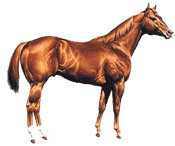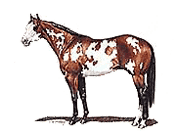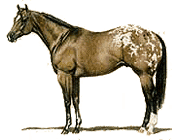Did You Know?
Did you know that America’s wild horses influenced the bloodlines of some of our most popular American breeds? Quarter Horses, Paint horses, and Appaloosas all had beginnings closely tied to the early wild horses of America.

Quarter Horse
Steel Dust was a foundation stud for what was to become the American Quarter Horse. Steel Dust himself was of Thoroughbred breeding and lived most his life in Texas. Steel Dust was a tremendous sprinter, and his widespread reputation as a running horse and as a sire of running horses caused many horsemen to desire his progeny. Since wild horses were readily available, ranchers would gather wild mares and breed them to Steel Dust or his descendants. The results were strong, durable mounts with good cow-sense. These horses became popularly know as “steeldusts.” Many “steeldust” horses were among the first to become part of the American quarter horse registry. The often overlooked heroine of the story is the wild mare who contributed her genetics of strength, endurance, and intelligence to this popular breed.

Paint Horse
History reports that in 1519 the Spanish explorer Hernando Cortes sailed to North America and brought with him a group of horses. One of those horses was reported to be a sorrel with white spots on its belly. By the early 1800s, the western plains were populated with wild horses, including horses of spotted color. This spotted horse type was a favorite of the Comanche Indians. This color pattern also became popular with other horse enthusiasts, and a registry for the color type was established in the 1950s, the Pinto Horse Association. Eventually, the American Paint Horse Association was born, which preserves the combination of spotted color and distinct bloodlines: those of the American Quarter Horse and Thoroughbred. However, the foundation stock for the paint horse color pattern was found in the original American wild horse of Spanish decent.

Appaloosa
The Appaloosa is a color breed cultivated by the Nez Perce Indians in the 1700s. The Nez Perce accumulated horses in the early 1700s when the wild horse herds spread to the Northwest, and they became excellent horsemen and breeders. It is reported that at the start of the Nez Perce War in 1877 they had at least 3000 horses and an estimated 10% of those horses possessed white spots irregularly scattered and intermixed with darker colors. These were the beginnings of today’s Appaloosa Horse, descended from careful breeding of America’s wild horse.

